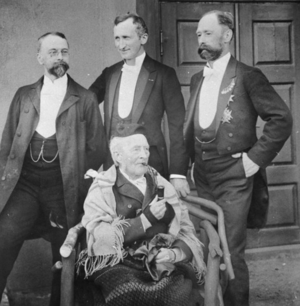Westye Egeberg (16 August 1770 – 27 February 1830) was a Danish born, Norwegian businessperson. He founded Westye Egeberg & Co. a Norwegian timber company that existed from 1800 to 1929. [1]

front: Westye Martinus Egeberg
from left: Einar Westye Egeberg, Theodor Christian Egeberg, Ferdinand Julian Egeberg
Biography edit
Egeberg was born on the island of Als at Sønderborg in the region of Syddanmark, Denmark. He re-located to Norway in 1786. He married Anna Sophie Muus (1775–1862) and was the father of several children including Westye Martinus Egeberg (1805-1898), physician Christian Egeberg (1809-1874) and composer Fredrikke Egeberg (1815–1861). [2]
In 1800, he founded the timber trade company Westye Egeberg & Co in Christiania (now Oslo), Norway. He purchased the Gahnsbruket timber lands in Fet near Lake Øyeren in Akershus. This formed the basis for an important lumber company and was passed on through generations. He controlled the company until his death in 1830. [3]
From 1830-51, his son Westye Martinus Egeberg managed the firm. Brothers Peder Cappelen Egeberg (1810-1874) and Christian August Egeberg (1809–1874) became co-owners and took control of the company in 1851. In 1874, management of the company was passed down to Ferdinand Julian Egeberg (1842-1921) and Einar Westye Egeberg (1851-1940). From 1911, Westye Parr Egeberg (1877-1959) controlled the firm. [4]
After the financial crash in 1929, the company and all assets were sold.
References edit
- ^ Hammer, S. C. (1926). "Egeberg, Westye Martinius". In Bull, Edvard; Jansen, Einar (eds.). Norsk biografisk leksikon (in Norwegian). Vol. 3 (1st ed.). Oslo: Aschehoug. pp. 426–429.
- ^ "Egeberg". Store norske leksikon (in Norwegian). Oslo: Kunnskapsforlaget. Retrieved 25 February 2011.
- ^ "Westye Egeberg & Co". Lokalhistoriewiki. Retrieved November 1, 2020.
- ^ Hammer, S. C. (1926). "Egeberg, Einar Westye". In Bull, Edvard; Jansen, Einar (eds.). Norsk biografisk leksikon (in Norwegian). Vol. 3 (1st ed.). Oslo: Aschehoug. pp. 424–425.